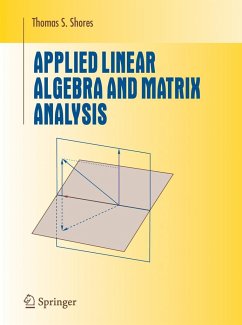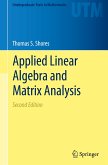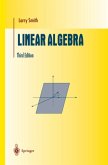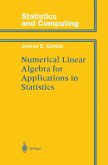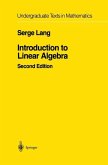This text is intended for a one or two semester sophomore levelcourse in linear algebra. It is designed to provide a balance ofapplications, theory and computation, and to emphasize theirinterdependence. The text has a strong orientation towardsnumerical computation and the linear algebra needed in appliedmathematics. At the same time, it contains a rigorous andself-contained development of most of the traditional topics in alinear algebra course. It provides background for numerousprojects, which frequently require computational tools, but is nottied to any one computational platform. A comprehensive set ofexercises and projects is included.
This book is about matrix and linear algebra, and their applications. For many students the tools of matrix and linear algebra will be as fundamental in their professional work as the tools of calculus; thus it is important to ensure that students appreciate the utility and beauty of these subjects as well as the mechanics. To this end, applied mathematics and mathematical modeling ought to have an important role in an introductory treatment of linear algebra. In this way students see that concepts of matrix and linear algebra make concrete problems workable. In this book we weave signi?cant motivating examples into the fabric of the text. I hope that instructors will not omit this material; that would be a missed opportunity for linear algebra! The text has a strong orientation toward numerical computation and applied mathematics, which means that matrix analysis plays a central role. All three of the basic components of l- ear algebra - theory, computation, and applications - receive their due. The proper balance of these components gives students the tools they need as well as the motivation to acquire these tools. Another feature of this text is an emphasis on linear algebra as an experimental science; this emphasis is found in certain examples, computer exercises, and projects. Contemporary mathematical software make ideal "labs" for mathematical experimentation. Nonetheless, this text is independent of speci?c hardware and software pl- forms. Applications and ideas should take center stage, not software.
This book is about matrix and linear algebra, and their applications. For many students the tools of matrix and linear algebra will be as fundamental in their professional work as the tools of calculus; thus it is important to ensure that students appreciate the utility and beauty of these subjects as well as the mechanics. To this end, applied mathematics and mathematical modeling ought to have an important role in an introductory treatment of linear algebra. In this way students see that concepts of matrix and linear algebra make concrete problems workable. In this book we weave signi?cant motivating examples into the fabric of the text. I hope that instructors will not omit this material; that would be a missed opportunity for linear algebra! The text has a strong orientation toward numerical computation and applied mathematics, which means that matrix analysis plays a central role. All three of the basic components of l- ear algebra - theory, computation, and applications - receive their due. The proper balance of these components gives students the tools they need as well as the motivation to acquire these tools. Another feature of this text is an emphasis on linear algebra as an experimental science; this emphasis is found in certain examples, computer exercises, and projects. Contemporary mathematical software make ideal "labs" for mathematical experimentation. Nonetheless, this text is independent of speci?c hardware and software pl- forms. Applications and ideas should take center stage, not software.
From the reviews:
"The book under review is a nice blend of three independent components of linear algebra: Theory, computation and applications. ... The book is consisting of the author preface, six chapters, table of symbols, solutions to selected exercises, a bibliography containing 13 references and subject index. ... The book is very useful for undergraduate students and nonspecialists." (Mohammad Sal Moslehian, Zentralblatt MATH, Vol. 1128 (6), 2008)
"This book is intended for a one or two semester course, with emphasis on linear algebra as an experimental science. ... The text is written in a nice conversational style. Proofs are provided for most results ... . The author also provides many computer exercises, projects, and report topics ... . Instructors wanting to encourage precision in mathematical writing will find these assignments helpful. ... This is a good text for those who want to introduce their students to applied discrete mathematics ... ." (Henry Ricardo, The Mathematical Association of America, September, 2008)
"The book under review is a nice blend of three independent components of linear algebra: Theory, computation and applications. ... The book is consisting of the author preface, six chapters, table of symbols, solutions to selected exercises, a bibliography containing 13 references and subject index. ... The book is very useful for undergraduate students and nonspecialists." (Mohammad Sal Moslehian, Zentralblatt MATH, Vol. 1128 (6), 2008)
"This book is intended for a one or two semester course, with emphasis on linear algebra as an experimental science. ... The text is written in a nice conversational style. Proofs are provided for most results ... . The author also provides many computer exercises, projects, and report topics ... . Instructors wanting to encourage precision in mathematical writing will find these assignments helpful. ... This is a good text for those who want to introduce their students to applied discrete mathematics ... ." (Henry Ricardo, The Mathematical Association of America, September, 2008)
"The book could be the basis of a course in matrices and linear algebra, and certainly deserves a place in a university library." (P. Macgregor, The Mathematical Gazette, Vol. 104 (560), July, 2020)

